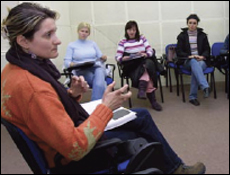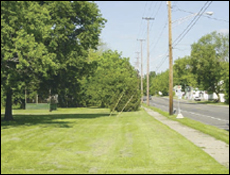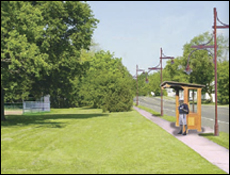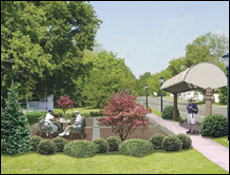The Small Town Design Initiative
- Warren J. Rauhe
- Landscape Architecture Program
- Colleges of Agriculture & Natural Resources and Social Science

Feedback loop: Students listen to a brainstorming session at a community meeting, come back with design ideas at the next meeting, listen to comments, and revise.
The notice on the library's community information board says the University is working with the neighborhood association to improve the neighborhood's physical design. There will be a meeting at the recreation center in two weeks.
A surprising number of people turn out for the meeting—maybe 100 or so. Warren Rauhe, a professor from MSU's landscape architecture program, explains that he is here to listen to community members create, through their words, a "picture" of what they want their neighborhood to look like in the next ten years. The idea is to turn the words into visual images that will help the community articulate a plan for revitalization. He calls this process the Small Town Design Initiative, and adds that since 2001 it has helped 50 communities in more than 30 Michigan counties plan for more inviting commercial districts and attractive living spaces.
In this first meeting, Rauhe asks three questions. First, he asks: "What are you proud of in your community?" People start calling out phrases that a student writes down on a flipchart:
"Compassion. We take care of each other."
"Open porches. We can interact with our neighbors."
"The diversity of people in our neighborhood."
As the list gets longer, the room is full of positive energy. Then a new sheet of paper goes up and Rauhe asks: "What are you sorry about in your community?" The residents appear deflated. A litany of negatives follows:
"The STDI provides an excellent service-learning opportunity and capstone experience for MSU landscape architecture students, while at the same time allowing for research opportunities in the area of community participation."
Warren Rauhe
"Boarded up buildings."
"The drug dealers and prostitutes."
"Not enough assistance for seniors."
Rauhe moves on to his final question: "If you were to float over your community in a hot air balloon 10 years from now, what would you like to look down and see?" The positive energy returns and the responses come almost faster than the note-taker can record them:
"A hardware store and a grocery shop."
"More coffee shops and restaurants."
"A retirement home."
Based on these responses, Rauhe, another professor, and about 20 university students gather a set of images from other communities that attempt to capture this community's "vision" for revitalization and bring them to a second meeting. As Rauhe presents each image, people call out comments:
"I like how they've used trees to separate the traffic from the pedestrians."
"Too futuristic for us."
"That's close. Let's build it."
At the third meeting the audience is presented with a set of design boards, each showing the neighborhood transformed in some way. The students present slides of their work and talk about what they're trying to achieve with each design. After the presentations, the community members walk around the room, carefully reviewing each design and writing down their comments on cards.
During the following months, community members review the designs at various locations around the neighborhood and on the Web site of the residents' association. They review hundreds of images, provide hundreds of comments, and attend more meetings. The students continue to refine the images as they receive comments.
At the final meeting, Rauhe shows 30 or so "before" and "after" images of key locations in the neighborhood that will guide future design plans. A local developer expresses an interest in turning one building into mixed-use housing. A nonprofit that assists newcomers is interested in turning a former grocery store into a micro-enterprise that will provide jobs and job training for its clients.
The residents' association is raising money for the necessary technical studies. But a lot of work still needs to be done. Undertaking some small projects that show immediate results would be a good start, Rauhe says. The association's chairperson asks for committee volunteers. Many people raise their hands.

Community members decided this bus stop had the potential to be friendlier and more inviting space...

Students prepared illustrations to present options for change...

A full-scale overhaul of the site might look like this.
- Written by Cathy Gibson, University Outreach and Engagement